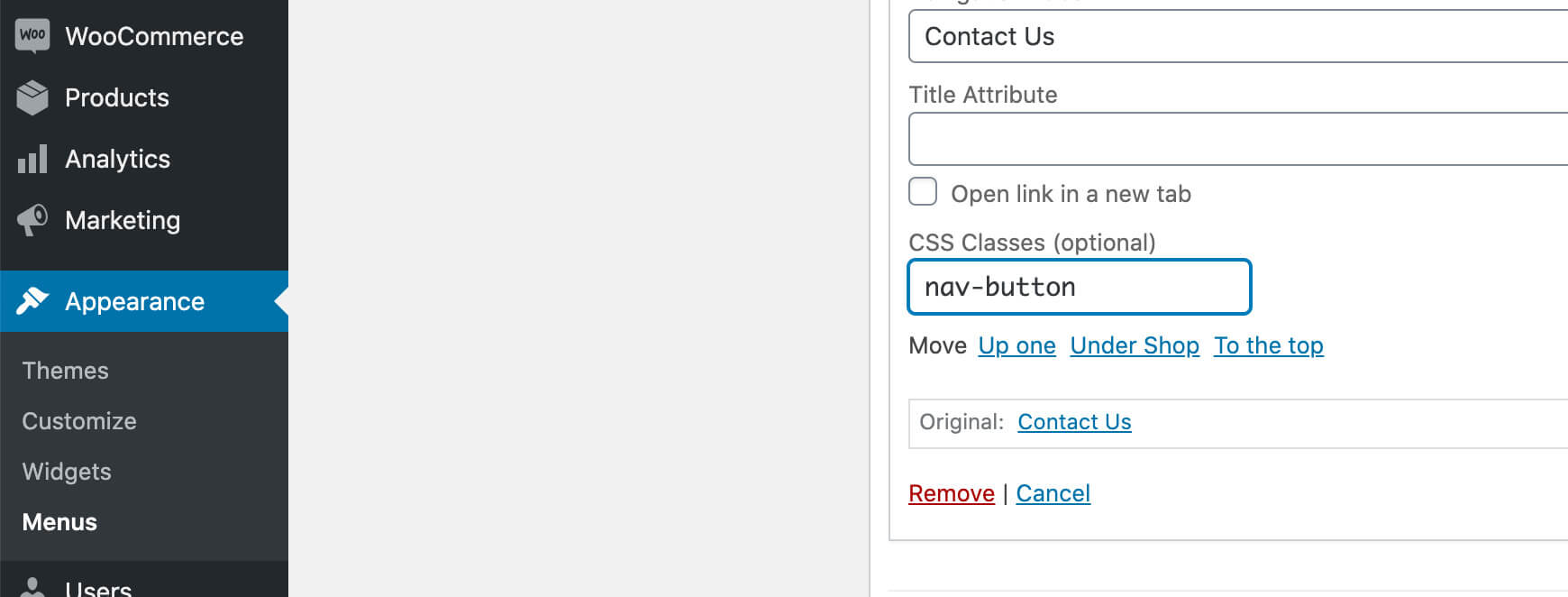Documentation for Cousteau Pro
Server Requirements
If you already have WordPress installed, it means that you meet the minimum server requirements and you can perfectly install this theme without any issues. To get the most out of your website though, you should get in touch with your web host and ask them if they meet the following criteria:
- PHP version 7.4 or greater.
- MySQL version 5.6 or greater OR MariaDB version 10.1 or greater.
- HTTPS support.
Prerequisites
Ignition Framework
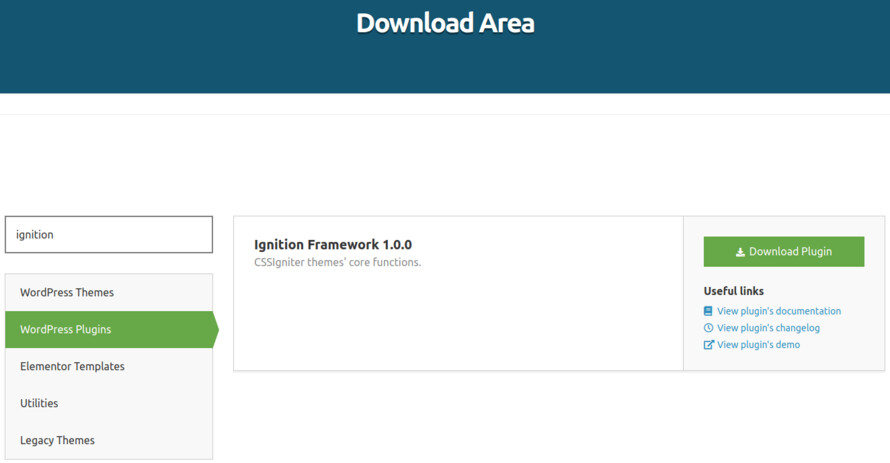
This theme requires our free Ignition framework plugin to be installed. Simply visit the Downloads area, download the Ignition Framework plugin, upload it through your Dashboard > Plugins > Add new and Activate it.
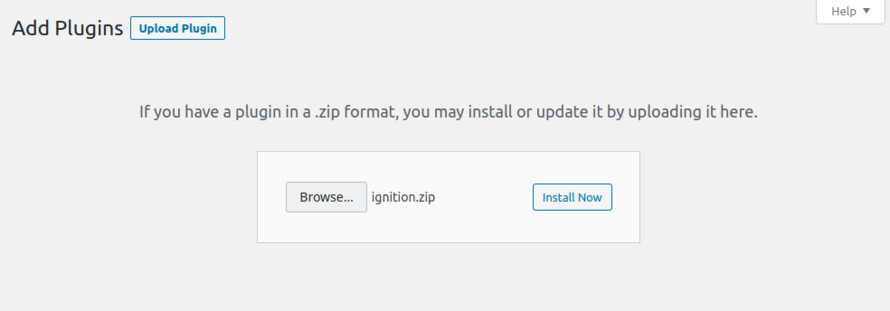
It really doesn’t matter if you install the theme or the plugin first. Just make sure to install both in order for things to function as intended.
Read this for more information about the plugin installation procedure.
Theme installation
Installing the theme is a very simple process. Go to your dashboard under Appearance > Themes > Add new, click Upload Theme and upload the zip file. Once uploaded click Install Now and then the Activate Theme link. Here is a detailed overview on how to download and install the theme.
Once the theme is installed and activated you will be forwarded to the theme’s onboarding page.
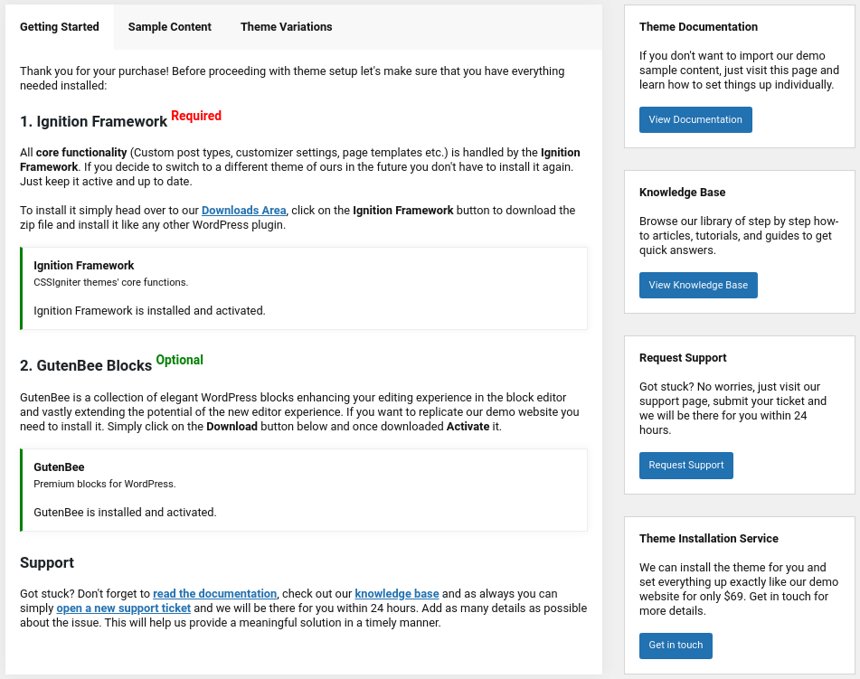
Here you will be prompted to install and activate the Ignition Framework plugin if you haven’t done so already. Here you can also install our free custom blocks plugin, GutenBee. Through the onboarding page you have access to many useful links, such as the theme’s documentation, our knowledge base articles and direct links to our support hub.
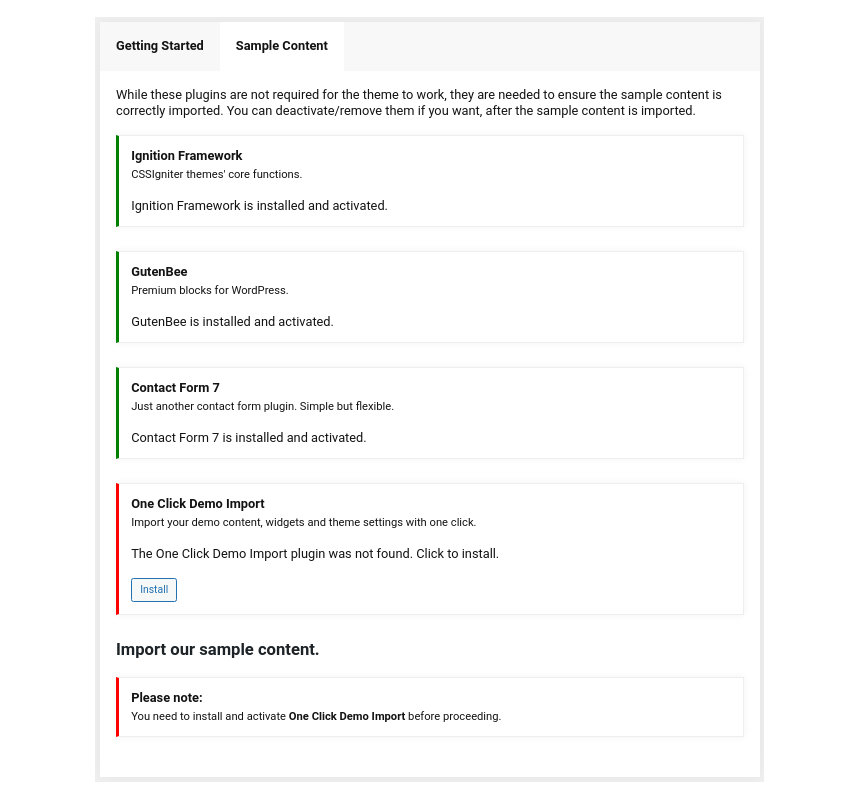
In the Sample Content tab of the onboarding page you can install and activate all the plugins required to import the sample content and proceed with its installation. More info on that on the next section.
How to import the sample content
If you like what you see in our demo website you can simply import the sample content. This means that a close approximation of our demo website will be imported in your WordPress installation. Now all you have to do is simply replace the content of these pages with your content. Importing the sample content can help serve as a basis on which you can continue to build and expand your site, however keep in mind that this procedure is entirely optional.
A generic video guide on how to import the sample content can be found here.
The procedure:
- In your WordPress dashboard visit Appearance > Theme Options > Sample Content.
- Click Install and then Activate for each of the required plugins.
- Click the Get Started button and in the next screen, move over the screenshot of the builder/variation of your preference and click the Import Demo button.
Image sizes
Web page loading times are greatly affected by the size of your images. For best results make sure to use images with the recommended dimensions as described below:
- Main post thumbnail: 870x580px
- Item: 615x410px
- Item large: 1170x780px
- Article Media 510x510px
- Mini-cart items 160x160px
- Package featured: 555x790px
Setting up site-wide sections
It’s considered a good practice to set up the areas of your website that you won’t be editing a lot in the future, like the general site layout, the header, footer and some secondary functionality.
General Site Options
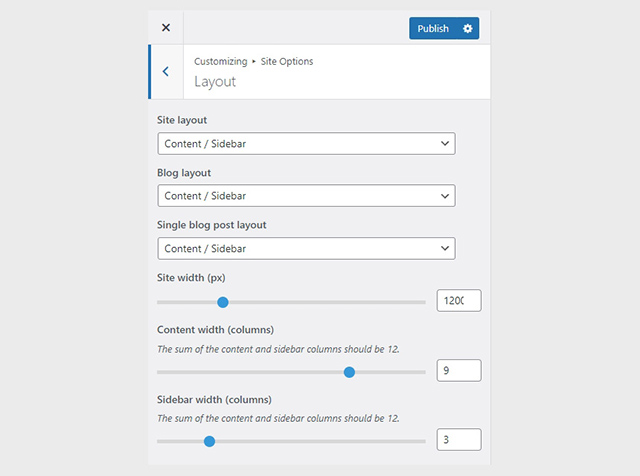
You can change your general site options under Appearance > Customize > Site Options. Under the Layout section you can control your site’s, blog’s and single blog post’s layout, as well as the site width and content/sidebar column ratio. The layout can then be overridden in each post/page individually. Under the Colors tab you can select the basic color palette for your installation and add a background image. Finally under Typography you can select the ideal font pairing from a full list of Google Fonts and customize font properties for key elements on desktop and mobile devices alike. You also have the option to disable Google Fonts altogether.
Header
The header’s type is set to transparent under Customizer > Header > Layout, the menu layout is set to right and the menu is sticky.
The header on the theme consists of three key elements:
1. Top Bar
2. Logo
3. Main Menu
The layout of the header can be set globally under Customize > Header > Layout.
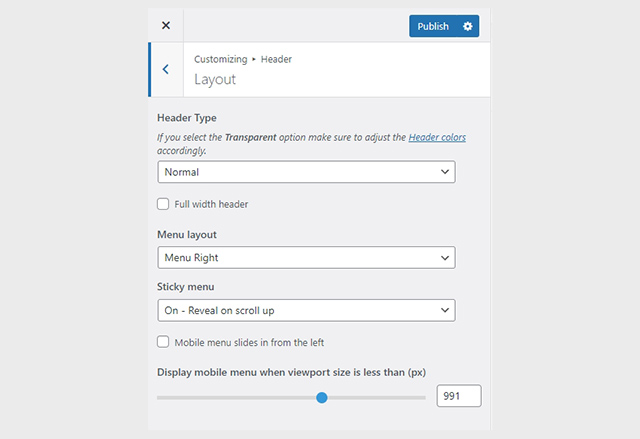
Top Bar
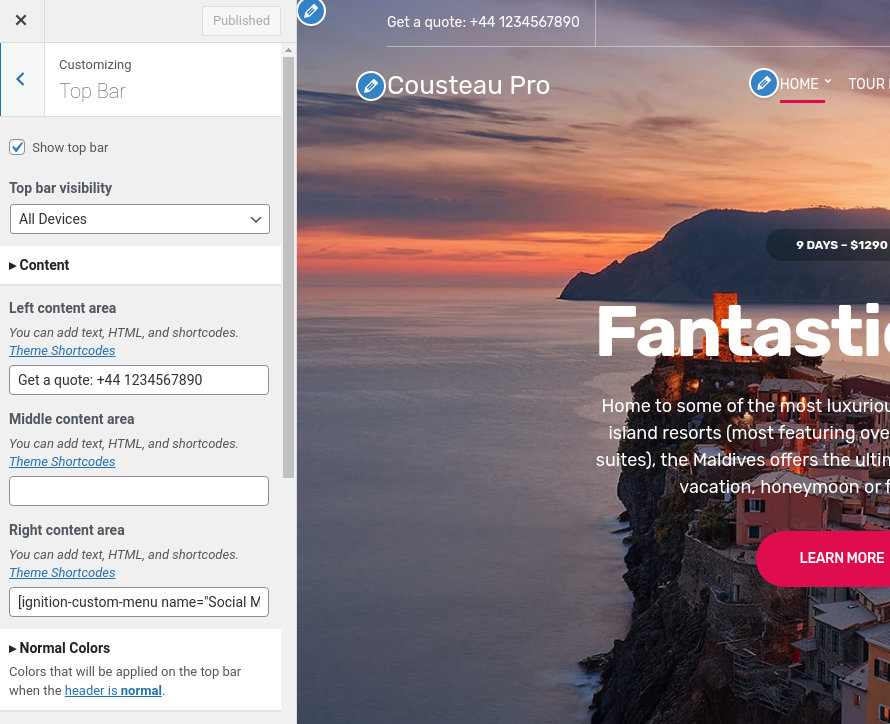
To edit the top bar go to Customize > Top Bar. Here you can toggle the top bar entirely and fill the 3 content areas with simple text, plain HTML, or shortcodes. We have used simple text on the left content area, a custom menu and a site search in the right one on the theme’s demo.
Refer to the shortcodes section below for information regarding the shortcodes.
Logo
On the theme’s demo we haven’t set a logo. To upload a logo navigate to Customize > Site Identity. The recommended maximum width of your logo is 200px (or 400px if you prefer a retina ready logo) while you can use any height you want. You can upload two logos. The normal and the alternative one. The alternative logo can be used if you want a different logo to appear when the header layout is set to Transparent under Customize > Header > Layout.
Learn more about the header and its options.
Main Menu
If you are not familiar with WordPress menus here is a detailed guide.
Navigate to Customize > Menus. Enter a menu name (It can be anything you like) and click on the Create Menu button. In the next page click the Add Items button and start adding items to the menu. Now all you have to do is assign this menu to a location through the Menu Locations section, check the Main menu location and you are done. Your navigation menu should be now visible on your website.
Create a menu button
You can create a special button-like menu item by setting a certain class for to it. The class name is nav-button and you can set it under Appearance > Menus for the item you want. First enable this section from Screen Options.
The page title section
This section allows you to create an area just below the menu which can display the page’s title & subtitle along with a background image or color.
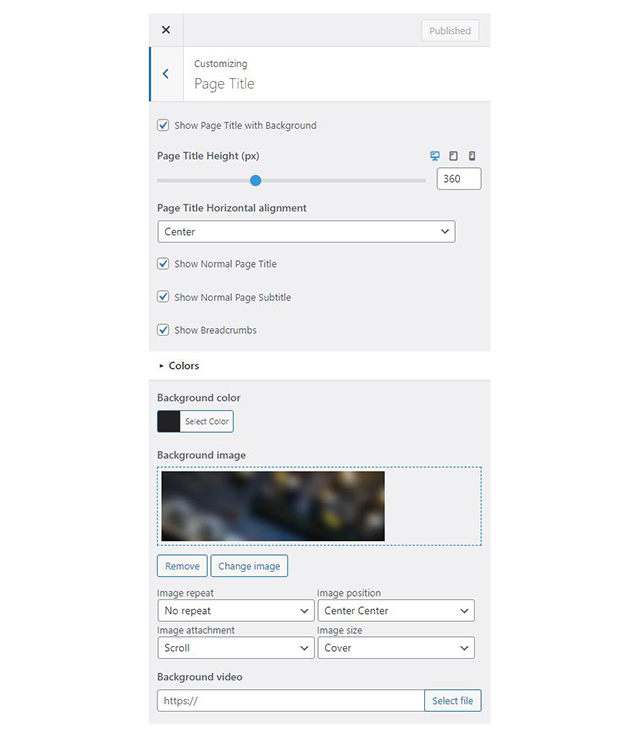
The page title section can be modified under Customize > Page title. You can choose to disable the page title with background section entirely, change its height, alignment, content and toggle the site’s breadcrumbs. Under the Colors section you can set a background color, a background image, an overlay color and also set the primary and the secondary text colors.
In some cases, like in our demo website, you might want to have different background images on different posts, pages and custom post types.
To achieve that create or edit a page. Under Page Settings > Page Title locate Background Image field. Upload a new image and preview this page. As you can see we have successfully overridden the image set in the Customizer settings.
In our Knowledge Base you can find more info about the page title section, the breadcrumbs and the page template overrides.
Footer
The footer area is a widgetized area that can be populated with widgets through Customize > Widgets. The footer can be turned of completely and its number of columns can be adjusted. Additionally users can also adjust the colors by setting a background color & image and modify the border, title and text colors.
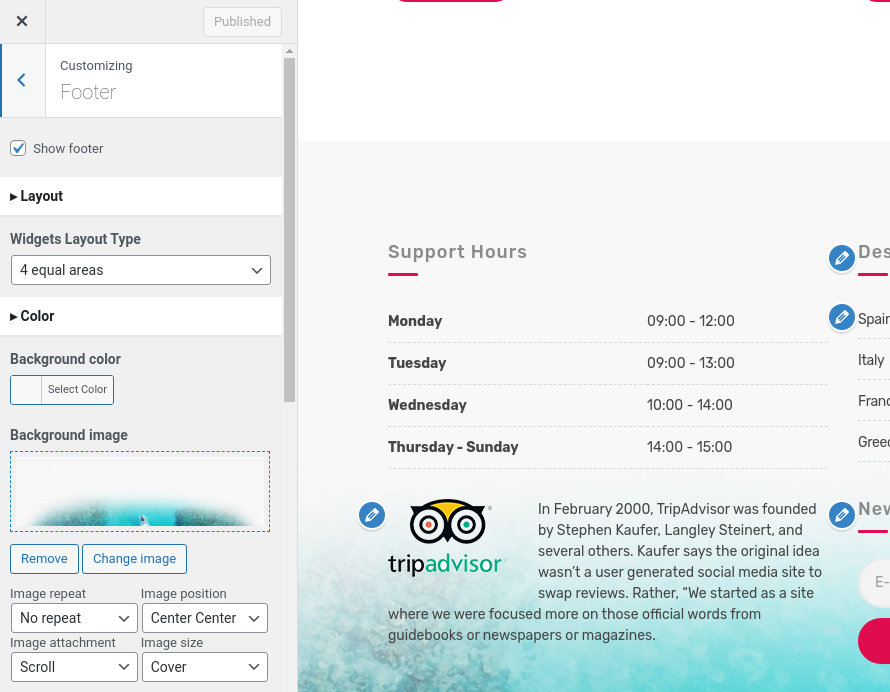
In the Credits content section you can replace the existing copyright information with yours or use any of the shortcodes included in the Ignition Framework.
Utilities
Lightbox
The theme offers a lightbox for your images which is by default disabled to avoid conflicts with third party plugins which offer lightboxes. If you want to use it you can enable it under Customize > Utilities > Lightbox.
Weather
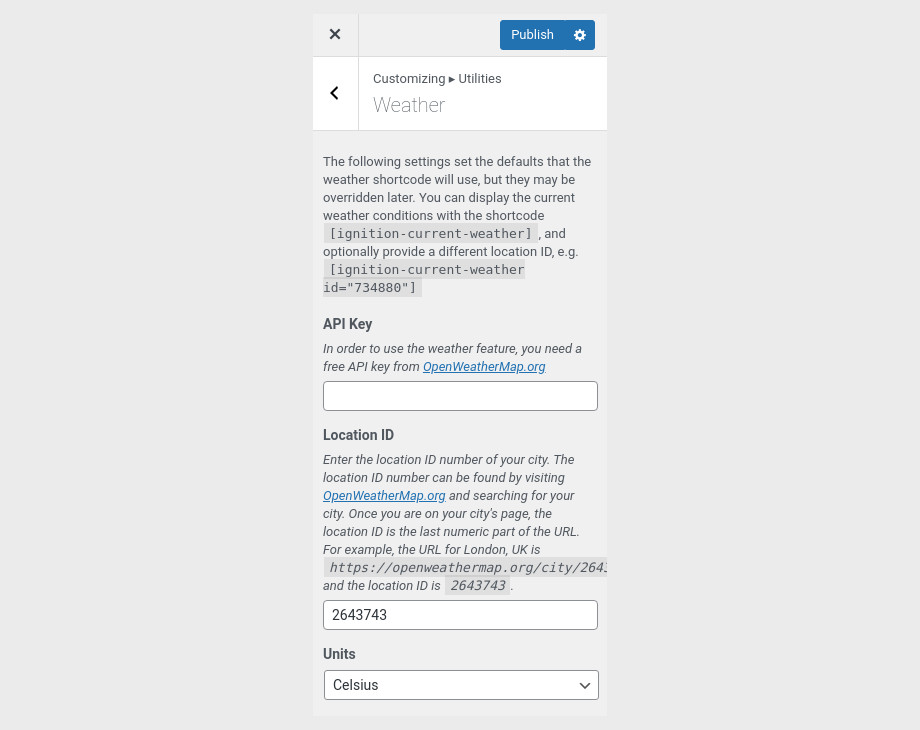
You can choose to show the weather for a chosen location using the weather shortcode anywhere inside your installation. First you will need to set it up by providing an API key and location under Customize > Utilities > Weather.
Block editor Dark Mode
Some themes have dark color schemes which are reflected in the block editor, this can make working with certain blocks a bit harder. Enabling the editor dark mode using the provided checkbox will apply certain styles to the editor in order to improve the content creation experience.
Social Sharing
Via the social sharing panel you can allow users to share your posts & products to Twitter, Facebook & Pinterest with a single click.
For more detailed information regarding the customization options available on Ignition Framework based themes you can check out this knowledge base article.
Custom post types
Create a new Package
Accommodation items on the demo have the Default template set to it under post attributes.
Navigate to Packages > Add New. Then under the Package tab start adding the basic item attributes. These are:
- Summary: Control the location and appearance of the sidebar. More info about these options can be found here.
- Destinations: Set a destination for the item which will also serve as a filter on the post type’s listing pages.
- Categories: Set a category for the item which will also serve as a filter on the post type’s listing pages.
- Featured image: Will appear on all related listings and on the item’s single page.
- Excerpt: Add a manual excerpt that will appear on post listings and on the page title section as a subtitle (if applicable).
- Discussion: Enable this option to allow your visitors to leave a rating/review.
- Page Title image: Set a custom post title background image for the item. Leave blank if you want to keep the default settings configured earlier.
- Page Settings: Here you can fine tune the item’s appearance. E.g. toggle the featured image, change header type, or hide the page title/subtitle. All our demo packages respect the Customizer options. Read more about page template configuration options.
- Package Settings: Through this group of options you can add all necessary info for the package. You can set the offer text if the item is on offer, enter its price & price text, the package’s duration & duration text, the listing button’s text and URL. The price & duration fields take a plain number and help with sorting functionality, the corresponding text fields are what appears to the site’s visitor.
Rating – Reviews
The package post type allows your visitors to leave a rating and a review regarding their experience with the product. The review section is a modified WordPress comments section with a star rating field. While user reviews accumulate their average will appear as a star rating at the top of the content and as a bar augmented star rating just below the content.
Setting up the pages
Home
Create a new page under Pages > Add New. Set the Full width boxed template to it under Summary and under Page Settings > Content Area remove the top/bottom padding, and under Pages Settings > Page Title set everything to hide.
Image
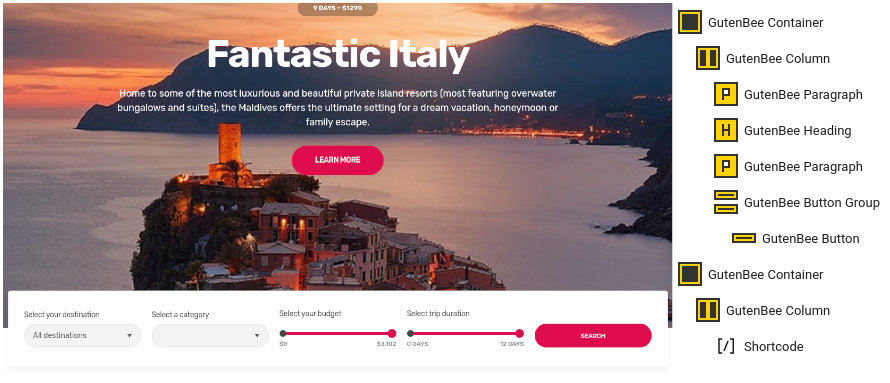
The page’s content starts with a fully aligned Container block. The theme grid is enabled, its height is set to -1, the vertical content alignment is set to middle and the horizontal one to center. Under block appearance it has a background image set. Inside the Container we find one column which contains a Paragraph, a Heading, another Paragraph and a Button.
Just below we have another Container with a single column inside it. The Column’s top margin is set to -100px. The Column houses a Core Shortcode block with the package search form shortcode
This shortcode will display a search form which allows your visitors to search for packages based on destination, vacation type, budget and duration.
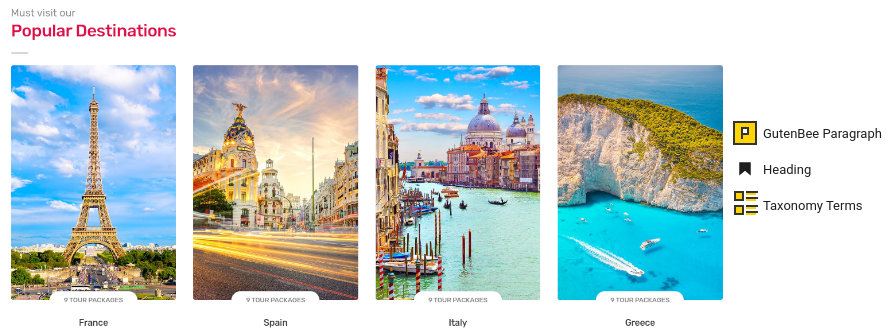
The Popular Destinations section starts out with a Paragraph as the overtitle, a Core Heading and a Taxonomy Terms block (provided by Cousteau Pro) with the destinations taxonomy selected and a four column layout.
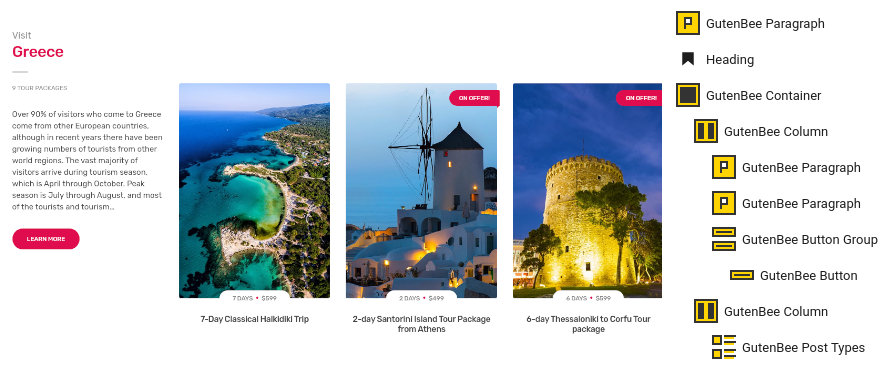
The visit Greece section starts with a Paragraph as an overtitle, a Core Heading and a Container block with two columns, the left column takes up 25% of the width and contains a couple of Paragraphs and a button, and the right column takes up the rest of the width and contains a Post Types block displaying three hand-picked packages.
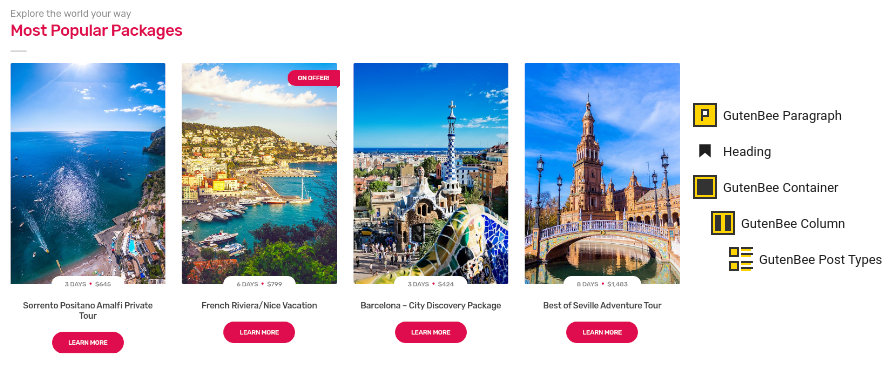
The Most Popular packages section starts out with a Paragraph as the overtitle, a Core Heading and a Container block with a single column containing a Post Types block which displays four hand-picked packages in a four column layout.
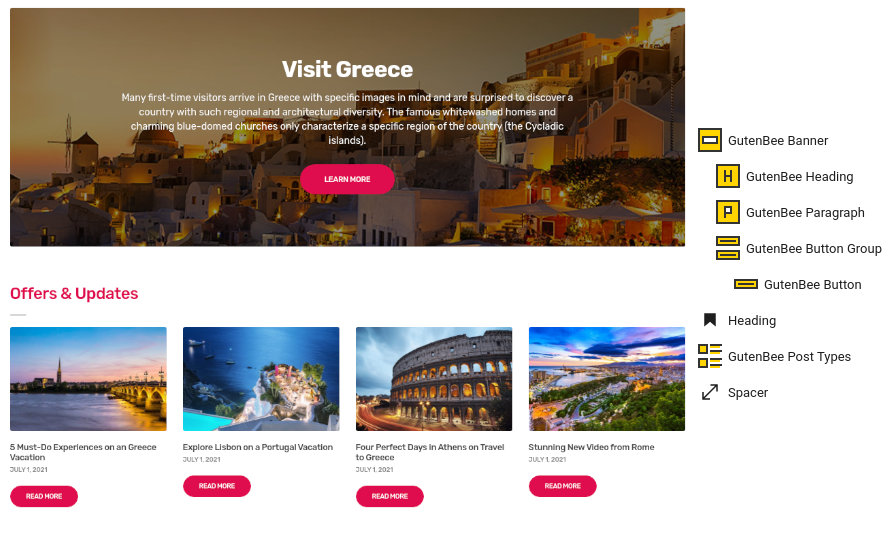
Next up we have a Banner block which sports a background image & overlay color with the parallax effect enabled. It has 90/200/90/200px padding, 55px top and 70px bottom margin. Inside we find a Heading, a Paragraph and a Button block.
Closing up the page we have a Core Heading, a Post Types block displaying the four latest posts in a four column layout and an 80px tall spacer.
Video
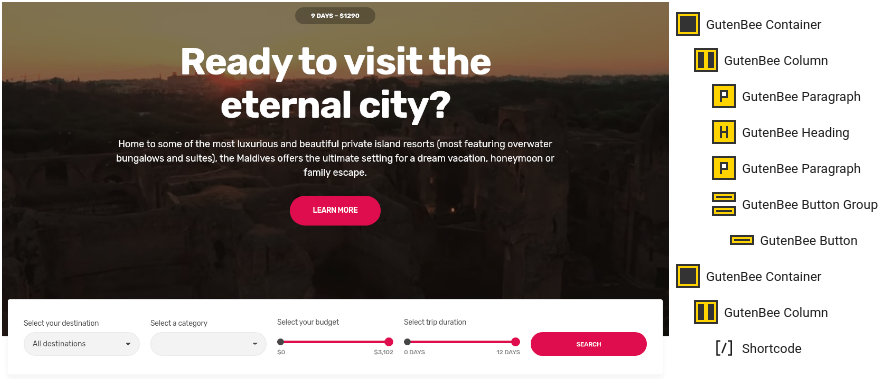
For the homepage with the video hero, what changes is that the Container block has a video background added under Block Appearance.
Slider
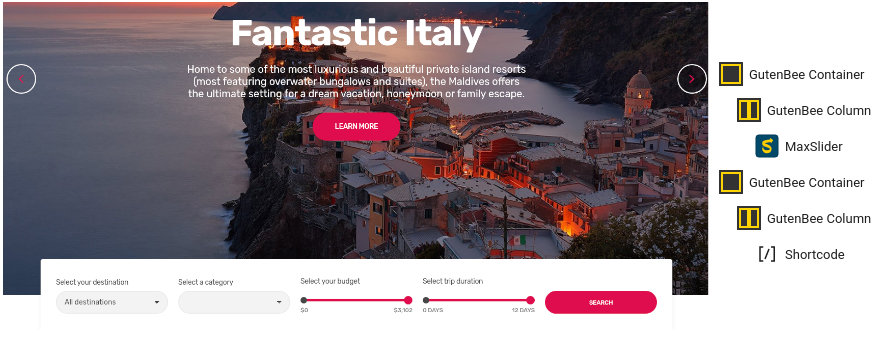
For the slider version, we replace the contents of the single column in the top Container with a MaxSlider block which provides us with our homepage slider.
Tour Packages
Create a new page and set the template to Content/Sidebar or Sidebar/Content under Summary, depending where you want the sidebar to appear, next add a Page Title > Background Image and you are good to proceed to the content.
Content wise we have a Post Types block displaying 12 items from the Packages post type in a three column layout with the pagination enabled and ordered by date.
To get the search box in the sidebar add a text widget in the Page sidebar under Customize > Widgets > Page and paste inside the package search form shortcode.
Destinations
The Destinations are taxonomy listings so to add them to your menu go to Appearance > Menus and enable Destinations under Screen Options, next add the destinations to your menu either from the same page or under Customize > Menus.
To get the same appearance as the one you see on the theme’s demo you need to fill in some information for each destination. To do that navigate to Packages > Destinations and edit a destination.
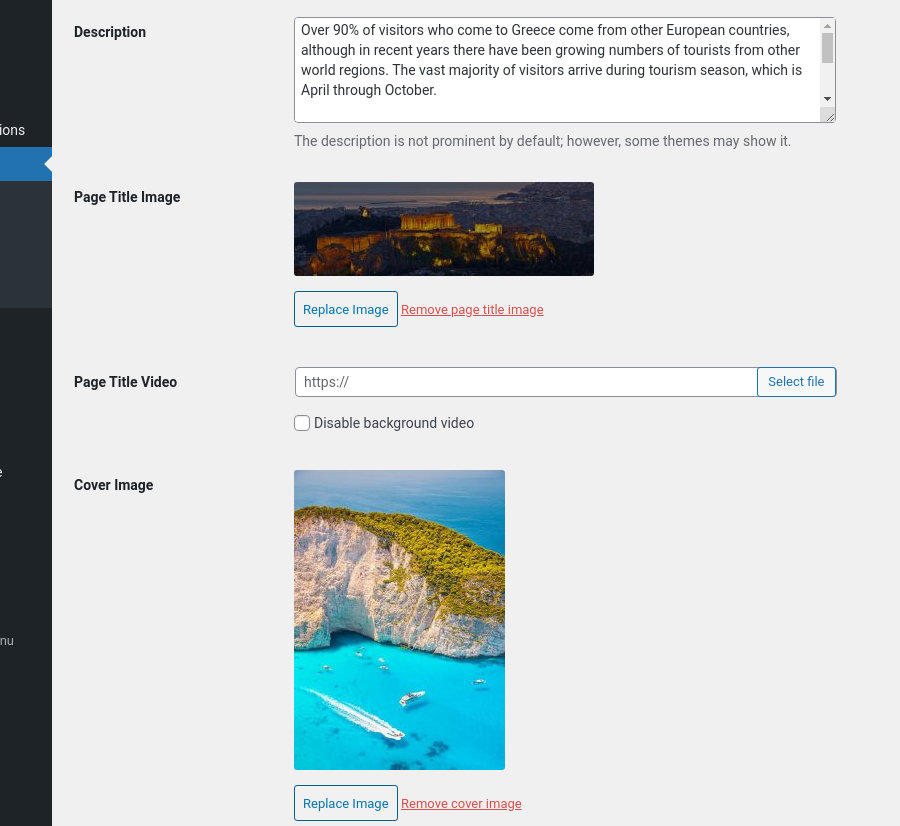
Here you will need to add the destination’s description, a page title image (optionally a page title video) and a cover image.
News
This is your main posts listing page. You can create a new page and set it as your posts page under Customize > Homepage Settings. You can customize it under Customize > Blog from the Archives section.
Brochures
The page has the Full width boxed template applied to it and a Page Title > Background Image set.
Content-wise things are pretty simple. We have a Container block with two columns. The left column covers 25% of the content’s width and contains a mix of Paragraphs and Headings to display the required information. The right column takes up the rest of the content’s width and contains 3 Container blocks with three equal columns each. Each of these columns contains an Image Box block with the image and description.
Get a quote
The get a quote has an identical content layout with the Brochures page above. The left Container column contains the same mix of Paragraphs and Headings and the right column contains a core Shortcode block housing a Contact Form 7 shortcode.
Search Tour Packages
This page (not visible on the demo’s menu, but can be seen if you use the package search form just below the homepage’s hero section) lists the results of the package search.
To recreate it create a new page with the Sidebar/Content template applied to it, add a small excerpt which will appear as the page’s subtitle, set a Page Title > Background Image and proceed to the content.
In the content place a single Core Shortcode block with the package search page shortcode. The shortcode accepts three parameters the per_page one which controls how may results will be shown, the columns one and the controls one which toggles the appearance of the layout & order controls. They are seen below with their default values.
To have the search form display in the sidebar you need to add the package search form shortcode in a text widget in the Page sidebar either under Customize > Widgets > Page or under Appearance > Widgets.
Common features
This section offers information on features common on all Ignition Framework based themes.
Shortcodes
The Ignition Framework offers a multitude of custom shortcodes these are:
Custom menu: [ignition-custom-menu name="your menu name"] Site search: [ignition-site-search] Date: [ignition-date] Weather: [ignition-current-weather id="your-location-id(optional)"] Minicart button: [ignition-minicart-button] Language switcher: [ignition-language-switcher] Icon link: [ignition-icon-link] Instagram Feed: [ignition-instagram-feed] WooCommerce search: [ignition-wc-search]
For more information have a look at this knowledge base article about shortcodes and their usage.
Page options
All themes offer six different templates which modify the location and appearance of the sidebar and the main content’s width.
Additionally pages have a common set of options which allow you to customize the appearance of the page title section, toggle breadcrumbs and more.
All settings are inherited from Customizer. So you can actually set some global settings and if you wish change certain pages to have different behavior.
Read the following article for a detailed explanation of the available templates and their options.
WooCommerce
Ignition Framework based themes are compatible with WooCommerce giving you the ability to create awesome online stores which perfectly match the appearance of the rest of your site.
WooCommerce is an optional plugin. You don’t need to install it if you are not looking to build an online store.
After activating WooCommerce it will create and set some default pages. These will serve as your Shop, Cart, Checkout and My Account pages.
The framework offers various customization options both for the main product listing page under Customize > WooCommerce > Product Catalog and for single products under Customize > WooCommerce > Single Products.
Learn more about the WooCommerce integration and the options offered here.
Global Sections
With the Global Sections custom post type included in all Ignition Framework based themes users can create content which can be easily reused in more than 15 key theme locations. For example users can create a newsletter subscription call to action box and immediately display it above the footer on all (or some) posts and pages, or create a banner ad an easily add it between posts in post listings etc.
Check out our knowledge base article for more information about Global Sections.
Blog page
This is you main blog page. You can create a new page and set it as your posts page under Customize > Homepage Settings. You can customize it under Customize > Blog from the Archives section.
Widget areas
The theme provides special widget areas for your posts listings, pages and shop. You can use a plugin/module like Jetpack’s widget visibility to hide or show widgets for certain pages, posts or products.
Support
If you need help during the initial installation and setup of this theme feel free to get in touch and we will get back to you within 24 hours to help.
